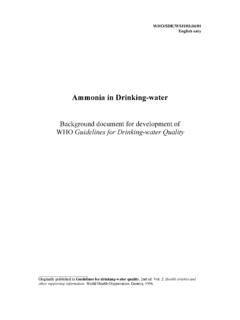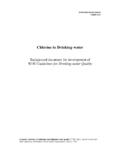Transcription of For the purposes of 40 CFR part 60 subparts OOOO and …
1 02/18 Miscellaneous Sources Industrial Flares General Flaring is a high-temperature oxidation process used to burn combustible components, mostly hydrocarbons, of waste gases from industrial operations. Natural gas, propane, ethylene, propylene, butadiene and butane constitute over 95 percent of the waste gases flared. In combustion, gaseous hydrocarbons react with atmospheric oxygen to form carbon dioxide (CO2) and water. In some waste gases, carbon monoxide (CO) is the major combustible component. Presented below, as an example, is the combustion reaction of propane. C3H8 + 5 O2 3 CO2 + 4 H2O During a combustion reaction, several intermediate products are formed, and eventually, most are converted to CO2 and water.
2 Some quantities of stable intermediate products such as carbon monoxide, hydrogen, and hydrocarbons will escape as emissions. Flares are used extensively to dispose of (1) purged and wasted products from refineries, (2) unrecoverable gases emerging with oil from oil wells, (3) vented gases from blast furnaces, (4) unused gases from coke ovens, and (5) gaseous wastes from chemical industries. Gases flared from refineries, petroleum production, chemical industries, and to some extent, from coke ovens, are composed largely of low molecular weight hydrocarbons with high heating value. Blast furnace flare gases are largely of inert species and CO, with low heating value.
3 Flares are also used for burning waste gases generated by sewage digesters, coal gasification, rocket engine testing, nuclear power plants with sodium/water heat exchangers, heavy water plants, and ammonia fertilizer plants. There are two types of flares, elevated and ground flares. Elevated flares, the more common type, have larger capacities than ground flares. In elevated flares, a waste gas stream is fed through a stack anywhere from 10 to over 100 meters tall and is combusted at the tip of the stack. The flame is exposed to atmospheric disturbances such as wind and precipitation. In ground flares, combustion takes place at ground level and is almost always unassisted.
4 Ground flares vary in complexity, and they may consist either of conventional flare burners with no enclosures or of multiple burners in refractory-lined steel enclosures. Ground flares may also be known as shielded Ground flares should not be mistaken for thermal oxidizers or incinerators. Ground flares operate under the same principals as elevated flares and combustion is achieved through the natural draft of combustion air. Thermal oxidizers and incinerators have combustion air blowers and can be tuned to control combustion chamber temperature, thereby allowing for more effective combustion control. The typical flare system consists of (1) a gas collection header and piping for collecting gases from processing units, (2) a knockout drum (disentrainment drum) to remove and store condensables and entrained liquids, (3) a proprietary seal, water seal, or purge gas supply to prevent flash-back, (4) a single- or multiple-burner unit and a flare stack, (5) gas pilots and an ignitor to ignite the mixture of waste gas and air, and, if required, (6) a provision for external momentum force (steam injection or forced air)
5 For a For the purposes of 40 CFR part 60 subparts OOOO and OOOOa and 40 CFR part 63 subparts HH and HHH, these units are not considered flares. The definition of flare in these subparts specifically exclude these units. In these subparts , a flare is defined as a thermal oxidation system using an open flame (without enclosure). Under these subparts , these units are considered combustion devices that must be field-tested. Alternatively, a unit tested by a manufacturer may be installed. EMISSIONS FACTORS 02/18 smokeless flaring. Natural gas, fuel gas, inert gas, or nitrogen can be used as purge gas. Figure is a diagram of a typical steam-assisted elevated smokeless flare system.
6 Combustion requires three ingredients: fuel, an oxidizing agent (typically oxygen in air), and heat (or ignition source). Flares typically operate with pilot flames to provide the ignition source, and they use ambient air as the oxidizing agent. The waste gases to be flared typically provide the fuel necessary for combustion. Combustible gases generally have an upper and lower flammability limit. The upper flammability limit (UFL) is the highest concentration of a gas in air that is capable of burning. Above this flammability limit, the fuel is too rich to burn. The lower flammability limit (LFL) is the lowest concentration of the gas in air that is capable of burning.
7 Below the LFL, the fuel is too lean to burn. Between the upper and lower flammability limits, combustion can occur. Flare waste gases with concentrations above the UFL will become more dilute as the waste gas mixes with ambient air above the flare tip. As this dilution occurs, the air-waste gas mixture will pass through the flammability region, and combustion will occur. However, if flare waste gas concentrations are near the LFL prior to mixing with air, the air-waste gas mixture can fall below the flammability region, and reduced combustion efficiencies can occur. If steam is added to the flare waste gas at or prior to the flare tip ( , prior to the combustion zone where the mixing with air occurs), the steam will act to dilute the waste gas.
8 Thus, even if there are adequate concentrations of combustibles in the waste gas, if too much steam is added to the waste gas so that the combustibles concentration becomes diluted to near the LFL as the steam-waste gas mixture enters the combustion zone, reduced combustion efficiencies will result. Consequently, critical considerations of flare combustion include the net heating value and the combustibles concentration in the flare gas and in the combustion zone ( , accounting for the amount of dilution by steam or other assist gas that occurs to the waste gas prior to the combustion zone). Figure Diagram of a typical steam-assisted smokeless elevated flare.
9 02/18 Miscellaneous Sources Combustion efficiency is the percentage of hydrocarbon in the flare vent gas that is completely converted to CO2 and water vapor. Destruction efficiency is the percentage of a specific pollutant in the flare vent gas that is converted to a different compound (such as CO2, CO or other hydrocarbon intermediate). The destruction efficiency of a flare will always be greater than the combustion efficiency of a flare. It is generally estimated that a combustion efficiency of percent is equivalent to a destruction efficiency of 98 Smoking may result from combustion, depending upon waste gas components and the quantity and distribution of combustion air.
10 Waste gases containing methane, hydrogen, CO, and ammonia usually burn without smoke. Waste gases containing heavy hydrocarbons such as paraffins above methane, olefins, and aromatics, have a higher tendency to smoke. An external momentum force, such as steam injection or blowing air, is used for efficient air/waste gas mixing and turbulence, which promotes smokeless flaring of heavy hydrocarbon waste gas. Other external forces may be used for this purpose, including water spray, high velocity vortex action, or natural gas. External momentum force is rarely required in ground flares. Steam injection is accomplished either by nozzles on an external ring around the top of the flare tip or by a single nozzle located concentrically within the tip.


















